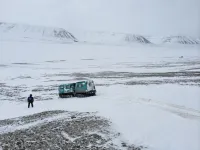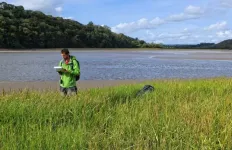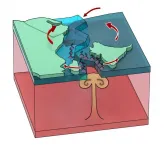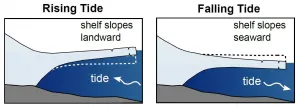(Press-News.org) Though writing by hand is increasingly being eclipsed by the ease of computers, a new study finds we shouldn't be so quick to throw away the pencils and paper: handwriting helps people learn certain skills surprisingly faster and significantly better than learning the same material through typing or watching videos.
"The question out there for parents and educators is why should our kids spend any time doing handwriting," says senior author Brenda Rapp, a Johns Hopkins University professor of cognitive science. "Obviously, you're going to be a better hand-writer if you practice it. But since people are handwriting less then maybe who cares? The real question is: Are there other benefits to handwriting that have to do with reading and spelling and understanding? We find there most definitely are."
The work appears in the journal Psychological Science.
Rapp and lead author Robert Wiley, a former Johns Hopkins University Ph.D. student who is now a professor at the University of North Carolina, Greensboro, conducted an experiment in which 42 people were taught the Arabic alphabet, split into three groups of learners: writers, typers and video watchers.
Everyone learned the letters one at a time by watching videos of them being written along with hearing names and sounds. After being introduced to each letter, the three groups would attempt to learn what they just saw and heard in different ways. The video group got an on-screen flash of a letter and had to say if it was the same letter they'd just seen. The typers would have to find the letter on the keyboard. The writers had to copy the letter with pen and paper.
At the end, after as many as six sessions, everyone could recognize the letters and made few mistakes when tested. But the writing group reached this level of proficiency faster than the other groups - a few of them in just two sessions.
Next the researchers wanted to determine to what extent, if at all, the groups could generalize this new knowledge. In other words, they could all recognize the letters, but could anyone really use them like a pro, by writing with them, using them to spell new words and using them to read unfamiliar words?
The writing group was better - decisively - in all of those things.
"The main lesson is that even though they were all good at recognizing letters, the writing training was the best at every other measure. And they required less time to get there," Wiley said.
The writing group ended up with more of the skills needed for expert adult-level reading and spelling. Wiley and Rapp say it's because handwriting reinforces the visual and aural lessons. The advantage has nothing to do with penmanship - it's that the simple act of writing by hand provides a perceptual-motor experience that unifies what is being learned about the letters (their shapes, their sounds, and their motor plans), which in turn creates richer knowledge and fuller, true learning, the team says.
"With writing, you're getting a stronger representation in your mind that lets you scaffold toward these other types of tasks that don't in any way involve handwriting," Wiley said.
Although the participants in the study were adults, Wiley and Rapp expect they'd see the same results in children. The findings have implications for classrooms, where pencils and notebooks have taken a backseat in recent years to tablets and laptops, and teaching cursive handwriting is all but extinct.
The findings also suggest that adults trying to learn a language with a different alphabet should supplement what they're learning through apps or tapes with good old-fashioned paperwork.
Wiley, for one, is making sure the kids in his life are stocked up on writing supplies.
"I have three nieces and a nephew right now and my siblings ask me should we get them crayons and pens? I say yes, let them just play with the letters and start writing them and write them all the time. I bought them all finger paint for Christmas and told them let's do letters."
INFORMATION:
The work was supported by the Science of Learning Institute at Johns Hopkins University, and the Dingwall Foundation Dissertation Fellowship in the Cognitive, Clinical, and Neural Foundations of Language.
Seismic waves passing through the ground near Longyearbyen in the Adventdalen valley, Svalbard, Norway have been slowing down steadily over the past three years, most likely due to permafrost warming in the Arctic valley.
The trend, reported in a new study published in Seismological Research Letters, demonstrates how seismic monitoring can be used to track permafrost stability under global climate change. The study is part of a focus section in an upcoming issue of the journal on Arctic and Antarctic seismology.
Julie Albaric of the University of Bourgogne Franche-Comté, while employed at NORSAR (Norway), and colleagues ...
Coastal wetlands - such as salt marshes - provide even more flood protection than previously thought, reducing the risk to lives and homes in estuaries, a new study has revealed.
The researchers' simulations showed that wetlands that grow in estuaries, such as salt marshes, can reduce water levels by up to 2 metres and provide protection far inland up estuary channels.
This subsequently saved up to $38 (£27) million in avoided flood damage costs per estuary during a large storm thanks to the wetlands' role in preventing storm floods.
The research is timely as wetlands are facing growing threats from continued urban development. 22 of the largest 32 cities in the world - including London, New York and Tokyo - are built on low-lying land around estuaries, ...
Populist anti-foreign aid rhetoric works - but only fans of populist politicians are convinced by hostile messages about charity abroad, a new study shows. Those who distrust populist politicians are significantly less susceptible to these messages.
The research shows international aid institutions and non-populist politicians should not be unduly worried about the impact of populism on global development cooperation.
Those wanting to convince the public about the importance of foreign aid should focus on communicating their message transparently and clearly, and using local partnerships.
The research, by A. Burcu Bayram from the University of Arkansas and Catarina Thomson from ...
Concerns have been raised about the AstraZeneca and Johnson & Johnson vaccines regarding very rare but potentially fatal side effects related to low blood platelet counts and blood clots. Recently, reports also emerged that the Pfizer-BioNTech vaccine may cause a rare yet serious side effect: heart inflammation. Concerns about side effects may trigger vaccine hesitancy, which the WHO considers one of 'Ten threats to global health'. Securing sufficient acceptance of vaccines is a key challenge in defeating the coronavirus pandemic, both now and in the future.
How ...
What happens when climate change affects the abundance and distribution of fish? Fishers and fishing communities in the Northeast United States have adapted to those changes in three specific ways, according to new research published in Frontiers in Marine Science.
Becca Selden, Wellesley College assistant professor of biological sciences, and a team of colleagues examined how fishing communities have responded to documented shifts in the location of fluke and of red and silver hake. The team found that fishers made three distinct changes to their approaches: following the fish to a new location; fishing for a different kind of fish; and bringing their catch to shore at another port of landing.
Selden began this research as a postdoctoral ...
July 8, 2021 - Until relatively recently, opioids were a mainstay of treatment for pain following total hip or knee replacement. Today, a growing body of evidence supports the use of multimodal analgesia - combinations of different techniques and medications to optimize pain management while reducing the use and risks of opioids, according to a paper in The Journal of Bone & Joint Surgery. The journal is published in the Lippincott portfolio in partnership with Wolters Kluwer.
"Multimodal analgesia has become the standard of care for total joint arthroplasty as it provides superior analgesia with fewer side effects than opioid-only protocols," write Javad Parvizi, ...
Augmented reality (AR) is poised to revolutionise the way people complete essential everyday tasks, yet older adults - who have much to gain from the technology - will be excluded from using it unless more thought goes into designing software that makes sense to them.
The danger of older adults falling through the gaps has been highlighted by research carried out by scientists at the UK's University of Bath and the Bath-based charity Designability. A Paper describing their work has received an honourable mention at this year's Human Computer Interaction Conference (CHI2021) - the world's largest conference of its kind.
The study concludes that adults aged 50+ are more likely to be successful at completing AR-prompted tasks (such as 'pick up the cube' followed by 'move the cube to the blue ...
Skoltech biologists and their colleagues from Koltzov Institute of Developmental Biology, Russia, and the Chemistry Department of Taras Shevchenko University in Ukraine have discovered fairly unlikely drug candidates for treating liver fibrosis and other pathologies -- among pest control chemicals. In addition, the team looked at modifications of the medication called hymecromone, deeming them promising for anti-fibrotic drugs, too. Published in Glycobiology, the study also sheds light on the possible mechanism of action of the investigated compounds, all of which inhibit the synthesis of hyaluronic acid.
Hyaluronic acid is an important biological compound that is a key component ...
The plates of the Earth's crust perform complicated movements that can be attributed to quite simple mechanisms. That is the short version of the explanation of a rift that began to tear the world apart over a length of several thousand kilometers 105 million years ago. The scientific explanation appears today in the journal Nature Geoscience.
According to the paper, a super volcano split the Earth's crust over a length of 7,500 kilometers, pushing the Indian Plate away from the African Plate. The cause was a "plume" in the Earth's mantle, i.e. a surge of hot material that wells upwards like an atomic mushroom cloud in super slow motion. It has long been known that the ...
WASHINGTON--Tidal stresses may be causing constant icequakes on Saturn's sixth largest moon Enceladus, a world of interest in the search for life beyond Earth, according to a new study. A better understanding of seismic activity could reveal what's under the moon's icy crust and provide clues to the habitability of its ocean.
Enceladus is about 500 kilometers in diameter and almost entirely covered in ice. The moon is nearly 10 times as far away from the Sun as Earth and its bright surface reflects most sunlight, making it very cold, yet researchers have long ...






